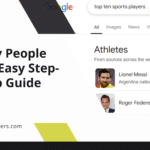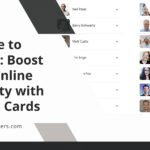|
Getting your Trinity Audio player ready...
|
In today’s digital age, having a strong online presence is crucial for the success of any business, especially for ecommerce websites. With millions of websites competing for attention, it is important to ensure that your ecommerce website stands out from the crowd. This is where search engine optimization (SEO) comes into play. SEO is the process of optimizing your website to improve its visibility and ranking on search engine results pages (SERPs). An SEO checklist is a comprehensive list of tasks and best practices that can help you optimize your ecommerce website for search engines.
The purpose of an SEO checklist is to provide a systematic approach to optimizing your website for search engines. It serves as a guide to ensure that you cover all the necessary aspects of SEO and don’t miss out on any important steps. By following an SEO checklist, you can improve your website’s visibility, attract more organic traffic, and ultimately increase your sales and revenue.
Key Takeaways
- SEO checklist items are crucial for ecommerce websites to improve their online visibility and drive traffic to their site.
- Keyword research and optimization is essential to identify the right keywords and phrases that potential customers are searching for.
- On-page optimization techniques such as optimizing meta tags, headers, and content can improve the relevance and quality of the website.
- Site structure and navigation should be user-friendly and easy to navigate to improve the user experience and search engine rankings.
- Mobile responsiveness and site speed are critical factors that affect user experience and search engine rankings.
Keyword Research and Optimization
Keyword research is a critical step in the SEO process for ecommerce websites. It involves identifying the keywords and phrases that your target audience is using to search for products or services similar to what you offer. By optimizing your website with these relevant keywords, you can increase your chances of appearing in search results when potential customers are looking for products or services like yours.
There are several techniques you can use to find relevant keywords for your ecommerce website. One approach is to use keyword research tools such as Google Keyword Planner, SEMrush, or Moz Keyword Explorer. These tools can provide valuable insights into the search volume, competition, and relevance of different keywords.
Once you have identified the relevant keywords, it is important to optimize them on your product pages and category pages. This can be done by including the keywords in the page titles, meta descriptions, header tags, and throughout the content on the page. However, it is important to avoid keyword stuffing, which is the excessive use of keywords in an unnatural way. Instead, focus on creating high-quality, informative content that incorporates the keywords naturally.
On-Page Optimization Techniques
On-page optimization refers to the process of optimizing individual web pages to improve their visibility and ranking on search engine results pages. For ecommerce websites, on-page optimization is crucial as it helps search engines understand the content and relevance of your product pages.
One important aspect of on-page optimization is optimizing title tags, meta descriptions, and header tags. Title tags are HTML elements that define the title of a web page and appear as the clickable headline in search engine results. Meta descriptions are brief summaries of the content on a web page and also appear in search engine results. Header tags, such as H1, H2, and H3, are used to structure the content on a web page.
To optimize these elements, it is important to include relevant keywords in the title tags, meta descriptions, and header tags. This helps search engines understand the content of your web pages and improves their visibility in search results. Additionally, make sure that these elements are unique for each page and accurately describe the content on the page.
Another important aspect of on-page optimization for ecommerce websites is optimizing product descriptions and images. Product descriptions should be unique, informative, and keyword-rich. They should accurately describe the product and its features, benefits, and specifications. Including high-quality images that showcase the product from different angles can also enhance the user experience and improve SEO.
Site Structure and Navigation
| Metrics | Description | Value |
|---|---|---|
| Number of Pages | Total number of pages on the website | 150 |
| Page Depth | Average number of clicks to reach a page from the homepage | 3.5 |
| Internal Links | Total number of links pointing to internal pages | 500 |
| External Links | Total number of links pointing to external websites | 200 |
| Broken Links | Total number of links that lead to a 404 error page | 10 |
| XML Sitemap | Presence of an XML sitemap that lists all pages on the website | Yes |
| Mobile Responsiveness | Website’s ability to adapt to different screen sizes | Yes |
The site structure and navigation of your ecommerce website play a crucial role in SEO. A clear and organized site structure helps search engines understand the hierarchy and relationship between different pages on your website. It also makes it easier for users to navigate your website and find what they are looking for.
When creating a site structure for your ecommerce website, it is important to categorize your products into relevant categories and subcategories. This helps search engines understand the different product categories on your website and improves the visibility of your category pages in search results.
Additionally, it is important to optimize your navigation menus and internal linking. Navigation menus should be clear, intuitive, and easy to use. They should provide easy access to different sections of your website, including product categories, subcategories, and individual product pages.
Internal linking is the process of linking different pages within your website. It helps search engines discover and index new pages on your website, improves the visibility of important pages, and enhances the user experience. When creating internal links, make sure to use descriptive anchor text that includes relevant keywords. This helps search engines understand the context and relevance of the linked pages.
Mobile Responsiveness and Site Speed
In today’s mobile-first world, having a mobile-responsive website is crucial for SEO. Mobile responsiveness refers to the ability of a website to adapt and display properly on different devices, including smartphones and tablets. Search engines prioritize mobile-friendly websites in their search results, so having a mobile-responsive website can significantly improve your visibility and ranking.
To optimize your ecommerce website for mobile responsiveness, make sure that it is built using responsive web design techniques. This ensures that your website automatically adjusts its layout and content to fit different screen sizes and resolutions. Additionally, optimize your images and videos for mobile devices by using compressed file formats and reducing their file sizes.
Site speed is another important factor that affects both user experience and SEO. Slow-loading websites can frustrate users and lead to high bounce rates, which can negatively impact your search engine rankings. To optimize your website’s speed, minimize the use of large images and videos, enable browser caching, compress CSS and JavaScript files, and use a content delivery network (CDN) to deliver your website’s content faster.
To test your website’s speed and mobile responsiveness, you can use tools such as Google PageSpeed Insights and Google Mobile-Friendly Test. These tools provide insights and recommendations for improving your website’s performance on mobile devices.
Content Creation and Optimization

Content creation and optimization are crucial for SEO, especially for ecommerce websites. High-quality, informative content can attract organic traffic, engage users, and improve your website’s visibility and ranking on search engine results pages.
When creating content for your ecommerce website, focus on providing valuable information that is relevant to your target audience. This can include product reviews, buying guides, tutorials, and blog posts. By providing useful content, you can establish yourself as an authority in your industry and build trust with your audience.
To optimize your content for SEO, make sure to include relevant keywords naturally throughout the content. This helps search engines understand the context and relevance of your content. Additionally, optimize your content by using descriptive headings, bullet points, and images to enhance readability and user experience.
Link Building and Backlinking Strategies
Link building is an important aspect of off-page optimization for ecommerce websites. It involves acquiring high-quality backlinks from other websites to improve your website’s authority and visibility in search engine results.
One effective strategy for building high-quality backlinks is to create valuable content that other websites would want to link to. This can include informative blog posts, infographics, videos, or industry reports. By creating valuable content, you increase the chances of other websites linking to your website as a reference or resource.
Another strategy for building backlinks is to reach out to other website owners or bloggers in your industry and ask them to link to your website. This can be done through email outreach or by participating in industry forums or communities.
It is important to note that when building backlinks, quality is more important than quantity. Focus on acquiring backlinks from reputable websites that are relevant to your industry. Avoid spammy or low-quality websites, as they can have a negative impact on your website’s SEO.
Social Media Integration and Optimization
Social media integration and optimization are important for SEO, as they can help increase your website’s visibility, drive traffic, and improve your search engine rankings.
To optimize your social media profiles for SEO, make sure to include relevant keywords in your profile descriptions, usernames, and hashtags. This helps search engines understand the context and relevance of your social media profiles.
Additionally, integrate social media into your ecommerce website by adding social sharing buttons to your product pages and blog posts. This allows users to easily share your content on their social media profiles, which can increase its visibility and reach.
Analytics and Tracking Tools
Analytics and tracking tools are essential for monitoring the performance of your ecommerce website and measuring the effectiveness of your SEO efforts.
Setting up and using analytics tools such as Google Analytics or Adobe Analytics can provide valuable insights into your website’s traffic, user behavior, conversion rates, and more. These insights can help you identify areas for improvement, track the success of your SEO efforts, and make data-driven decisions to optimize your website.
In addition to analytics tools, there are also tracking tools that can help you monitor the performance of specific SEO metrics. For example, there are tools that can track keyword rankings, backlinks, website speed, and mobile responsiveness. By regularly monitoring these metrics, you can identify any issues or opportunities for improvement and take appropriate actions.
Continuous Monitoring and Maintenance of SEO Efforts
SEO is an ongoing process that requires continuous monitoring and maintenance. Search engine algorithms are constantly evolving, and new competitors are always entering the market. Therefore, it is important to stay up-to-date with the latest SEO best practices and make necessary changes to your website to maintain its visibility and ranking.
To monitor the performance of your ecommerce website, regularly check your website’s analytics data to identify any changes in traffic or user behavior. If you notice any significant drops in traffic or rankings, investigate the possible causes and take appropriate actions to address them.
Additionally, stay up-to-date with the latest SEO trends and algorithm updates by following industry blogs, attending webinars or conferences, and participating in online communities. This will help you stay ahead of the competition and make informed decisions to optimize your website.
In conclusion, an SEO checklist is a valuable tool for optimizing ecommerce websites for search engines. By following the checklist and implementing the recommended strategies and techniques, you can improve your website’s visibility, attract more organic traffic, and ultimately increase your sales and revenue. However, it is important to remember that SEO is an ongoing process that requires continuous monitoring and maintenance. By regularly monitoring your website’s performance, staying up-to-date with the latest SEO best practices, and making necessary changes, you can ensure that your ecommerce website remains competitive in the ever-changing digital landscape.
If you’re looking to optimize your ecommerce website for search engines, you need a comprehensive SEO checklist. One article that can help you with this is “Maximizing Your Online Presence: How an SEO Optimization Company in India Can Help” by Media Officers. This article provides valuable insights into the role of SEO services in improving your website’s visibility and driving organic traffic. It discusses the various strategies and techniques used by SEO companies to boost your online presence and increase your chances of success in the competitive digital landscape. Check out the article here for more information.
FAQs
What is SEO?
SEO stands for Search Engine Optimization. It is the process of optimizing a website to improve its visibility and ranking on search engine results pages (SERPs).
Why is SEO important for ecommerce websites?
SEO is important for ecommerce websites because it helps them to attract more organic traffic, increase their visibility, and improve their ranking on search engine results pages. This can lead to more sales and revenue for the ecommerce business.
What is an SEO checklist for ecommerce websites?
An SEO checklist for ecommerce websites is a list of tasks and best practices that ecommerce businesses can follow to optimize their website for search engines. It includes things like keyword research, on-page optimization, technical SEO, and link building.
What are some key elements of an SEO checklist for ecommerce websites?
Some key elements of an SEO checklist for ecommerce websites include optimizing product pages with relevant keywords, creating unique and high-quality content, optimizing images and videos, improving website speed and performance, and building high-quality backlinks.
How can ecommerce businesses improve their website’s on-page SEO?
Ecommerce businesses can improve their website’s on-page SEO by optimizing their product pages with relevant keywords, creating unique and high-quality content, optimizing images and videos, improving website speed and performance, and using internal linking to improve website structure.
What is technical SEO and why is it important for ecommerce websites?
Technical SEO refers to the process of optimizing a website’s technical elements to improve its visibility and ranking on search engine results pages. It is important for ecommerce websites because it helps to improve website speed and performance, ensure website security, and make the website more user-friendly.
What is link building and how can it help ecommerce websites?
Link building is the process of acquiring high-quality backlinks from other websites to improve a website’s visibility and ranking on search engine results pages. It can help ecommerce websites by increasing their domain authority, improving their search engine rankings, and driving more organic traffic to their website.

























































